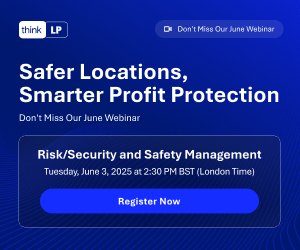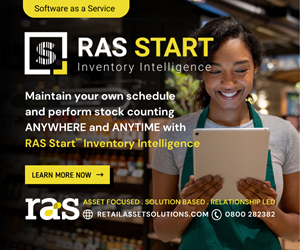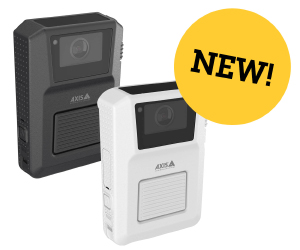INDUSTRY FOCUS
2018 Retail Loss Challenge
The Four-Month Hunt for Innovation in Loss Prevention
By Colin Peacock, ECR Community
It does not take many store visits or trade magazine reviews to come to the realisation that retail is changing, and changing more dramatically than ever before. Retailers are increasingly pressured to provide an easier, faster, and more frictionless shopping experience for shoppers, wherever they are, at whatever time. Alongside this, higher costs (such as salaries, rent and taxation, and intense price competition) are challenging the current operating model of many traditional retailers. The retail industry loses in excess of $230 billion every year due to theft, damage, and error. The requirement for new thinking, technology, and different ways of working has never been more important.
Yet a recurring criticism from retail loss prevention executives of the traditional technology providers has been that while they are working on important iterations of existing interventions, they are not necessarily addressing their most pressing concerns and emerging retail loss challenges. On the other hand, the technology provider community frequently bemoans the lack of feedback from the retail community on what issues they would like to see addressed. It would not be unfair for them to say, “How can we help you if you don’t tell us specifically the problem you want us to solve?”
To help tackle this paradigm, the ECR Community Shrink & OSA Group launched the Retail Loss Challenge in February 2018 with the aim of bringing to their members new technology interventions that can meet what they themselves have declared as their most pressing concerns.
What Is the Retail Loss Challenge?
The Retail Loss Challenge was a four-month global hunt for the world’s hottest start-ups and innovative companies with scalable solutions to tackle specific retail loss challenges. Finalists were invited to meet loss prevention experts representing over thirty retailers for a “speed dating” session in June with the five most promising start-ups competing in a Shark Tank style pitch to loss prevention leaders for the chance to run an in-store trial.
To kick-start the hunt, the ECR Community Shrink & OSA Group appointed CO:CUBED, a London-based corporate innovation agency, to help manage the process. The first step was to interview representatives from the five retailers that had agreed to be the “sharks,” namely Ahold Delhaize, John Lewis, Lidl, Sainsbury’s, and Tesco, to understand first-hand the key loss prevention challenges they are facing and the potential role for new technology.
The Five Retail Loss Challenges
Challenge 1: How Can Retailers Enable Frictionless Shopping and Manage the Risk of Loss?
Shoppers today increasingly demand a seamless and hassle-free in-store experience, particularly when it comes to checking out. That means offering shoppers a speedy and convenient way to pay for their goods and leave the store. Self-scan technology, which among other things provides more choice and convenience to shoppers, is now commonplace. In fact, for some retailers, self-checkout approaches including scan-as-you-go, scan-bag-and-go, tap-and-go, and the emerging near-zero-friction technologies can represent over half of all in-store transactions.
While this technology can lead to an improved customer experience, it also presents its own challenges from a loss perspective. Sometimes customers make mistakes. For example, if they are not familiar with the technology, they might mis-scan or accidentally fail to scan items (non-malicious loss). Unassisted checkouts can also be seen as an easier target for theft, for example with items intentionally being placed in bags without being scanned (malicious loss).
So as frictionless shopping becomes a growing focus, how can retailers continue to deliver a great customer experience while reducing the risk of loss from customer error, missed-scans, non-scans, duplicate scanning, theft, fraud, and walk-outs?
What We Sought. We were searching for innovation that could help retailers enhance the unassisted checkout experience in a cost-effective way while reducing the risk of non-malicious and malicious loss. Ideally, we sought interventions that prevent and/or reduce the chance of mistakes happening in the first place, for example, helping alert the shopper when an error has occurred and making it easy for retailers to detect errors and theft in real time. All of this needs to work in a retail context where fewer store associates are on the shop floor.
Challenge 2: How Can Retailers Minimise Loss of High-Risk Products?
Retail crime costs the industry billions every year. Criminals who target certain desirable products, either for their own use or for resale, drive a significant part of the problem. Professor Ron Clarke coined the acronym CRAVED (concealable, removable, available, valuable, enjoyable, and disposable) to help explain why some products such as cigarettes, steaks, legs of lamb, spirits, aftershave and perfume, chewing gum, coffee, and others, are targeted. His observation was that items easily resold in bars, on the streets, online, or in smaller stores, for example, would be more attractive to thieves.
While it would be relatively simple for retailers to reduce the risk of theft by securing these items behind closed display units, they also need to ensure that shoppers are getting a great in-store experience. This means merchandising these items in a way that is convenient for shoppers to buy and simple for staff to stock. Think of those expensive spirits or luxury hand-creams encased in clunky plastic boxes or locked behind a display case. They may make it harder for criminals to steal, but they also make it difficult for customers to touch, interact with, and learn more about the product. So how can retailers optimise the shopping experience for items that are highly attractive to criminals while minimising the risk of theft—all in the context of having fewer staff on the shop floor and an increasing number of unassisted checkouts?
What We Sought. We were searching for cost-effective interventions that can help retailers better protect these highly targeted items from theft, without impacting the shopper experience. The challenge was open to ideas and inspiration from beyond the retail industry.
Challenge 3: How Can Retailers Use Technology to Enhance Colleague Safety?
Providing a safe and secure environment for shoppers and staff alike is paramount to retailers. Sadly, store managers, associates, and security personnel are at risk of abuse. In the UK alone, retailers have seen violence and physical attacks against retail staff increasing by 40 per cent in the last twelve months.
Security challenges can range from organised attacks from criminal groups to petty theft to abusive or aggressive members of the public. A significant proportion of incidents are thought to be linked to confrontation arising when store colleagues attempt to intercept suspected shoplifters. Risk is not limited to store-based colleagues. Delivery drivers can be targeted when transporting valuable goods or delivering to certain locations, for example. Visible deterrents, such as having more security personnel on the shop floor, are an effective measure but are not cost-effective in many cases.
What We Sought. Prevention is always the best cure, so we were looking for innovations that train and equip staff to protect themselves, eliminate the need for intervention to manage incidents, or influence the perception of risk (through store design, placement of staff, and so forth) to avoid confrontations in the first place.
Challenge 4: How Can Retailers Leverage the Full Potential of Data to Manage Loss?
The age of big data is here. The retail industry is already awash with masses of information, and with the rise of the IoT, sensors, beacons, smart appliances, video analytics, facial recognition, and more, the richness of that data is set to explode.
This presents retailers with a big opportunity when it comes to managing loss and improving the shopper experience. For example, if retailers could see real-time information on point of sale, risk, stock levels, and external data such as demographic information, they could more effectively manage their deployment of security equipment and personnel. Using data to track the movement of product through the supply chain could help pinpoint areas of loss, so preventive measures can be put in place. The challenge is that many of these data sources are unconnected or hard to interpret, making it difficult for retailers to make sense of the information.
What We Sought. We were seeking technology that can help retailers bring together disparate data sources, allowing them to translate that data into actionable insights that give retailers a holistic view of everything that is happening in-store and throughout their supply chains. This includes technology that can gather detailed insights on customer behaviour to help detect and deter theft or violence, whilst still being compliant with GDPR.
Ideally, these interventions would identify the areas of loss, theft, or damage, and/or quantify what product is in-store at any one time and how those goods are moving through the supply chain (for example with the return or sale-or-return process), while at the same time allowing them to better predict loss and risk. This includes solutions that can help retailers understand when an item has arrived in the store, when it is sold to a customer, when it is returned by the same customer, or when it is sent for reclaim or transferred to another store.
Challenge 5: How Can Retailers and Law Enforcement Collaborate to Reduce Crime and Violence?
Collectively, retailers and law enforcement incur costs in the billions to protect stores, customers, staff, and inventory from the rising problem of in-store violence, fraud, and theft. In the UK alone, there were 3.6 million incidents of retail crime last year.
In addition to the actual cost of crime, there’s also the cost of preventing and managing criminal activity. Every retailer invests significant resources to counteract this, such as installing security cameras, recruiting security personnel, attending court, dealing with legal representatives, and so forth. With law enforcement resources stretched, Police response to incidents of crime or violence can be inconsistent. This can lead to a perception among criminals that they are able to offend without any apparent repercussions.
While retailers continue to work towards reducing crime, efforts may often be duplicated between different retailers, areas, and Police forces as they seek to detect and deter the same small cohort of violent individuals and criminal gangs responsible for a large proportion of losses.
What We Sought. In an environment where law enforcement and the judiciary have reduced resources to deter and prosecute retail crime, we were looking for interventions that improve the efficiency of reporting and prosecuting offenders. We were seeking technologies that can enable a more connected approach across the industry and make crime prevention efforts more effective. This includes solutions that enable collaboration across retailers and/or law enforcement to make it easier to prosecute those responsible for violence, theft, and fraud.
Uncovering New Innovation
Over 200 companies applied against these challenges, and following three rounds of rigorous judging, the following five were selected to pitch:
Supersmart (supersmart.co.il) makes shopping faster and easier by enabling instant checkout of fully loaded trollies, bypassing queues, in less than half a minute. The retail world is craving innovation. Retailers seek efficient, cost-saving checkout systems while shoppers seek fast and easy shopping experiences.
Cartwatch (cartwatch.de) prevents retail theft using artificial intelligence and computer vision by integrating into existing camera infrastructure. They offer a growing array of solutions, including the prevention of theft at the checkout as well as the open entrance.
Strivr (strivr.com) is transforming the way companies train and develop their employees through the use of immersive technology. The end-to-end platform includes creation tools, flexible content management, and prescriptive analytics and insights.
Standard Cognition (standardcognition.com) is eliminating the hassle of retail checkout by removing it entirely. They offer the only artificial-intelligence-based autonomous checkout system available to any retailer that lets consumers shop and pay without waiting in line, scanning, or stopping to check out.
Auror (auror.co) helps retailers stop organised retail crime in their stores by streamlining the capture of information, connecting the dots on repeat offenders or organised groups, and fostering collaboration between stores, retailers, and law enforcement.
Almost twenty pilots have already been agreed upon for start-ups to trial their solutions with retailers, and progress will be reviewed at the end of the year. We will report on progress of the trials in a future article.
About the ECR Community Shrink & OSA Group
For nearly twenty years, we have been promoting the value of collaboration and bringing new insights, tools, and best practices to the industry based on research the group has commissioned with academia. Group members include Ahold Delhaize, Carrefour, Duracell, John Lewis, Lidl, M&S, Procter & Gamble, Sainsbury’s, S Group, and Tesco.
Research the group has published is available to download free of charge from the ECR website. European retailers and manufacturers can also attend any of the group’s meetings free of charge. If you are interested in supporting ECR, please write to colinmpeacock@ecr-shrink-group.com.
COLIN PEACOCK is a visiting fellow at the University of Leicester and the strategic coordinator for the ECR Community’s Shrinkage & OSA Group. Prior to these appointments, he had a thirty-year career at Gillette and Procter & Gamble. Peacock can be reached at colinmpeacock@ecr-shrink-group.com.






